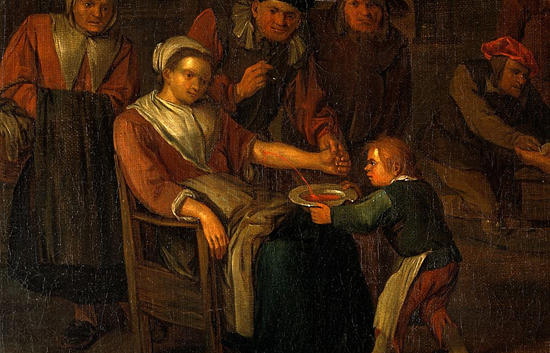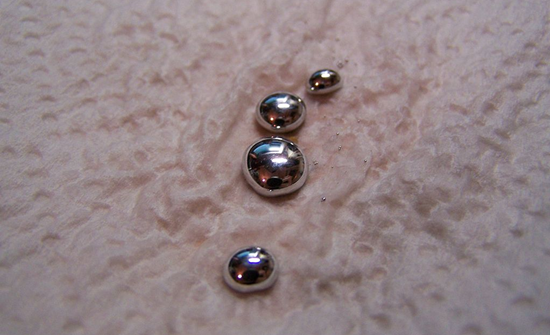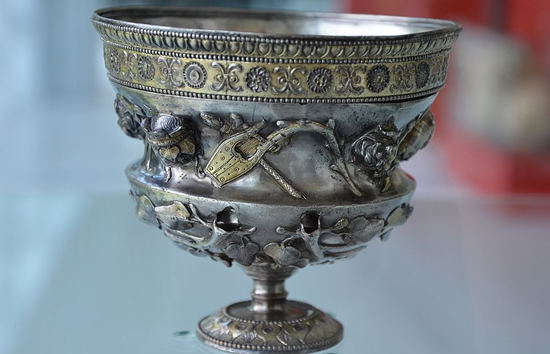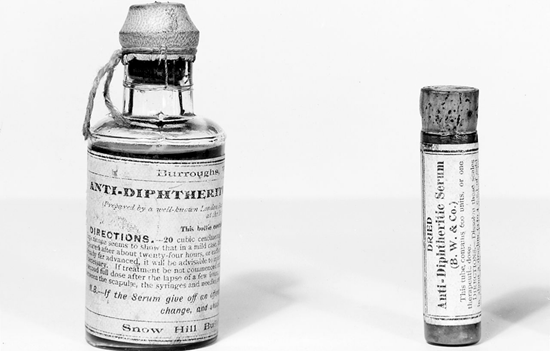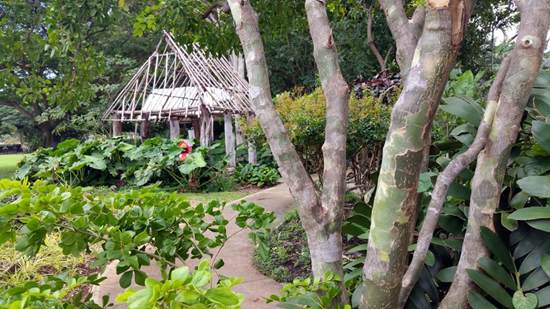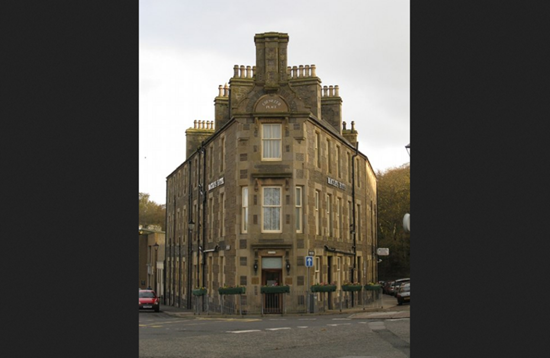
10 Ways That Doctors Treated Infections Before Antibiotics
By Patrick J. Kiger, How Stuff Works, 25 March 2016.
By Patrick J. Kiger, How Stuff Works, 25 March 2016.
Back in 1928, a Scottish scientist named Alexander Fleming was checking petri dishes containing cultures of Staphylococcus bacteria, when he discovered something that surprised him. One dish had been contaminated by a mold, which seemed to have secreted something that had stopped the growth of the bacterial colonies around it. Other scientists took Fleming's discovery and eventually turned it into a drug called penicillin, which became the first effective cure for diseases such as pneumonia, gonorrhea and rheumatic fever [source: ACS].
Penicillin was one of the world's first antibiotics, a class of drugs that fight infections by killing bacteria or keeping them from reproducing [source: MedlinePlus]. Since they were introduced in the 1940s, antibiotics have saved millions of lives across the planet, and become one of the most heavily relied-upon remedies for infectious diseases.
Unfortunately, antibiotics' effectiveness has caused them to be massively over-prescribed and misused as well. Half of the antibiotics given to humans in the U.S., for example, are prescribed for viral diseases such as colds and the flu, which don't respond to them. And for years, they've been given to farm animals to spur growth. As a result, doctors are now finding that many common bacterial diseases - such as urinary-tract infections and pneumonia - increasingly don't respond to antibiotics that once controlled them effectively [source: Randall].
To make matters worse, pharmaceutical companies aren't developing new antibiotics rapidly enough to replace the ones that are becoming ineffective. As a result, we may have no choice but to look anew at older methods that doctors used to treat infections in the centuries before antibiotics were developed. Here are 10 of those pre-antibiotic treatments and how well they worked.
10. Honey
Honey, a plant nectar that is modified by the honeybee (Apis mellifera), has long been prized not just as a food but also as a medicine. The ancient Egyptians mentioned it at least 500 times in their medical literature, and used it in more than 900 of their remedies for various ailments. When Egyptian soldiers were wounded in battle by swords or other weapons, doctors usually applied honey to their wounds to promote healing and prevent infections [source: Gabriel]. The Assyrians, Chinese, Greeks and Romans similarly relied upon the product [source: Dente].
While using the sweet stuff for wound care might sound foolish, modern scientists have discovered that the ancients actually were on to something. Experiments show that honey actually has such powerful antimicrobial abilities that it can kill wound bacteria in less than two days on average, and in some cases as quickly as 10 hours after application - performance that rivals modern antibiotics. Honey draws water from bacterial cells, causing them to die without reproducing, and also contains glucose oxidase, an enzyme secreted by bees that is a powerful natural disinfectant and a mild antibiotic [source: Gabriel].
A recent German study found honey so effective in preventing infections among pediatric cancer patients that the study's author recommended that doctors consider using it on difficult-to-heal wounds [source: Dente].
9. Bloodletting
When honey didn't do the trick, the ancient Egyptians used bloodletting to treat patients with dangerous infections. The treatment grew out of a medical theory that the body contained four fluids, or "humors," which included blood, phlegm, black bile and yellow bile. (From this, we get words like "choleric" and "phlegmatic" to describe people's personalities.) It was believed that for a person to be healthy, those four fluids had to be kept in balance, and that infections resulted not from microbes - which were unknown in those days - but from an excess of blood [source: Columbus].
Sometimes, doctors would bleed a patient by making an incision in a vein or artery. They also used a technique called cupping, in which heated glass cups were placed on the skin. That created a vacuum and broke numerous small blood vessels, so that the patient bled over a larger area beneath the skin. Sometimes leeches were used for bloodletting [source: Columbus].
Though it seems dangerous and grisly today, bloodletting may actually have had some effectiveness against certain types of bacteria, at least in the early stages of an infection. The microbes require iron to reproduce themselves, and depriving them of the red blood cells that carry iron might make it more difficult for the invaders to sustain the infection [source: Columbus].
8. Maggots
During the Napoleonic wars, a surgeon noticed a curious phenomenon: Soldiers whose wounds became infested with maggots - larvae of the green bottle fly - seemed to heal better than those whose didn't. Disgusting as the idea might seem, doctors subsequently began deliberately infesting their patients as a defense against infection. But maggot debridement therapy, or MDT [pictured above], as it was known, quickly fell into disfavor after antibiotics came into use during World War II [source: Dente].
Now that antibiotics are becoming less effective, doctors are taking a second look at maggots, using sterile larvae that do not reproduce or feed on living tissue. The tiny creatures basically eat the bacteria in a wound and then degrade the microbes in their digestive tracts. Additionally, they secrete an enzyme that is a natural disinfectant, dissolves dead tissue and stimulates healing.
Research shows that maggots are particularly effective at fighting MRSA (Methicillin-resistant Staphylococcus aureus), the drug-resistant microbe that is a deadly threat in hospitals, as well as other drug-resistant microorganisms. One study shows that in badly infected limbs, maggots managed to kill off microbes and eliminate the need for amputation in 40 to 50 percent of cases. They're now officially recognized as medical devices by the U.S. Food and Drug Administration, and maggot therapy is reimbursable by Medicare [source: Dente].
7. Mercury
Since ancient times, people have been fascinated with mercury, due to the metal's glistening silver color and its liquid state at room temperature. The ancient Chinese thought that red mercury sulfide, a compound of mercury, had the ability to increase longevity and vigor, and medieval Arabs used it in ointments to treat skin diseases [sources: Norn, et al., Andrews].
Mercury became a go-to treatment when syphilis began to spread through Europe in the late 1400s. The disease's symptoms - genital sores, followed by foul abscesses, ulcers that could eat into bones and destroy facial features, severe pain and eventually death - quickly made it one of the most feared diseases around [source: Frith]. Doctors applied mercury to patients' skin; injected it into their bodies or had them swallow it or bathe in its fumes.
Mercury actually did have some effectiveness as a treatment, since it kills the spirochete bacteria that causes the disease [source: Stromberg] However, it may have done more harm than good to the patients, because the metal is a powerful toxin that damages the kidneys, causes brain damage and may lead to death [source: Columbus].
6. Silver
Silver has been prized for thousands of years as a purifying agent and medicine. The ancient Greek historian Herodotus wrote that Persian kings would only drink water that was transported in silver containers which kept it fresh. In the 1500s, Paracelsus, a Swiss physician, began applying it to wounds and giving it to patients orally. Other doctors followed suit. In the 1880s, German obstetrician Carl Siegmund Franz Crede started treating newborn infants with eye drops containing a silver solution to protect them from being blinded by gonorrheal ophthalmia. The following decade, a surgeon named B.C. Crede started using colloidal silver - water with silver particles suspended in it - to keep wounds from being infected [source: Alexander].
The use of silver as an antimicrobial agent continued into the 1900s. Surgeons used silver foil for wound dressings, and they often closed incisions with silver sutures [source: Alexander].
While the advent of antibiotics diminished silver's role, the metal actually is an effective bacteria killer. Silver ions, modern research reveals, attack the microbes' membranes, punching holes in them and wreaking more havoc inside by binding to essential cell components such as DNA. In one test, silver killed more than 99.99 percent of the microbes in the sample. While silver is generally safe, it can cause upset stomach, convulsions or even death in high doses [source: Conover].
5. Cinchona Bark
Herbs have been used over the centuries to fight disease. One such plant was the bark of the cinchona tree, which is native to South America. Back in the 1600s, Jesuit missionaries described how the bark could be dried, ground into powder, and then mixed with water to make a drink to treat people suffering from fevers. The missionaries probably learned about the treatment from native people, who'd been using it for a long time [source: Columbus].
This cure was not just a folk remedy. Cinchona bark became the source of a drug, quinine, which until the early 1900s was the only effective treatment for malaria. Quinine is an alkaloid that interferes with the growth and reproduction of the malarial parasites that take over a victim's red blood cells. The one catch is that quinine only kills those invaders, but not the ones who take over other cells in the victim's body. As a result, people who used quinine, often became sick again a few weeks later.
During World War II, better, manufactured treatments, such as chloroquine, were developed. However, as the malarial parasite that transmits the disease has become resistant to these synthetic drugs, quinine has been making a comeback - the parasite is still sensitive to it [source: Britannica.com].
4. Garlic
This plant from Asia has been used as a medicine for thousands of years. In ancient China, garlic was one of the most popular remedies as far back as 2700 B.C.E., and physicians used it as a treatment for depression. In India, it was prescribed for treating coughs, skin disease, rheumatism and even hemorrhoids.
Medieval Europeans mixed garlic with honey in teas and tinctures, and used it to fight infectious diseases that caused fevers and bacteria. Marseille residents were given garlic as a treatment during an outbreak of bubonic plague in the 1700s [source: Petrovska and Cekovska].
In the early 1900s, doctors gave people garlic during influenza outbreaks as a protective medicine. The belief in garlic's powers was so strong that during the flu epidemics of 1917 and 1918 in the U.S., some people wore necklaces of garlic around their necks when they went out in public. During World War II, the Soviet Army actually used it instead of penicillin. No wonder garlic was called "Russian penicillin" [source: Petrovska and Cekovska].
While garlic isn't quite the miracle cure that people wanted it to be, it does contain allicin, a substance that can kill a wide range of bacteria, including multidrug-resistant strains of E. coli [source: Ankri and Mirelman].
3. Serum Therapy
If you've strolled in New York's Central Park, you may have noticed the statue honoring Balto, the Siberian husky who braved the elements to bring lifesaving medicine to the inhabitants of Nome, Alaska, during a 1925 diphtheria epidemic. But what Balto risked his hide to haul wasn't antibiotics. Instead, the trusty canine brought with him a load of serum, a product made from the blood of animals such as horses, and containing antibodies that they'd developed from being exposed to the disease. The idea was that when the serum was injected into humans' bodies, it fought the bacterial invaders again [source: Koerth-Baker].
Serum therapy was invented in the 1890s, and one of its discoverers, Emil von Behring, was awarded a Nobel Prize for his work [source: Nobelprize.org]
Serum therapy largely was supplanted by antibiotics - diphtheria, for example, is now treated with penicillin and erythromycin [source: MedLine Plus]. But the concept hasn't completely gone away. When the Ebola epidemic raged through West Africa in 2014, for example, the World Health Organization considered giving victims a serum made from the blood of people who had recovered from the infection [source: Kupterschmidt].
2. Bacteriophages
Living in the old Soviet Union had a lot of downsides, but a potentially fatal one was the lack of access to the antibiotics that Western pharmaceutical companies were developing. In order to compensate for that problem, the Soviet Union focused instead upon developing the use of bacteriophages - that is, viruses that kill bacteria [source: Reardon].
The idea of using viruses as bacteria killers actually was first suggested by a British bacteriologist, Ernest Hankin, who theorized in 1896 that some sort of a microbe in the waters of the Ganges and Jumna rivers in India was limiting the spread of cholera. A Canadian microbiologist, Felix d'Herelle, demonstrated in 1915 that a virus was capable of taking over a bacterium and living off it like a parasite. French and U.S. efforts to develop drugs based on the discovery, however, lost steam once antibiotics became big. But in the Soviet Union and Communist Eastern Europe, the treatments became an alternative to those unavailable antibiotics [source: Sukakvelidze, et al.].
Recently, U.S. scientists began looking anew at bacteriophage therapy as a possible way to cope with rising antibiotic resistance. Unlike antibiotics, which kill all bacteria in their path (both good and bad), phages kill just one strain of bacteria. If the bacterium becomes resistant to that phage, another one is added to the viral mix a patient might receive [source: Reardon].
1. Guaiacum
Guaiacum officinale trees. Credit: Wendy Cutler/Flickr, CC BY-SA 2.0.
Here's another anti-infection remedy that involves tree bark. Back in the 1500s, when syphilis was raging through Europe, desperate sufferers - or at least, the ones who hadn't yet been poisoned with mercury - tried an extract called guaiacum, or holy wood. It came from a tree native to the Caribbean and the Americas. Part of the treatment's appeal was that it came from the New World, where Europeans assumed that their explorers had contracted the disease and brought it back across the ocean [source: Edward Worth Library].
The theory at the time was guaiacum would unclog the body's excretory system and pores, allowing the infected blood to be purified [source: Varey and Chabran]. Syphilis patients were given the bark extract in a hot drink, and then subjected to a "sweating cure" [source: Edward Worth Library].
Guaiacum became so popular that a conspiracy theory developed that doctors weren't prescribing it because it might cure patients and cut physicians' income. It became even more expensive because the Holy Roman Emperor Charles V. awarded an importation monopoly to the banking house of Fugger. But by the 1540s, the demand was falling off, because people began suspecting that it didn't work. They continued using mercury until 1910, when arsenic came into vogue as the cure for syphilis [sources: Varey and Chabran, Frith].
Author's Note: This was an interesting assignment because I've been concerned about the growing microbial resistance to antibiotics. When I was growing up in the 1960s, I remember that we thought of them as wonder drugs. These days, when I go to the doctor, she is reluctant to prescribe them unless I'm really, really ill.
Related Articles:
More Great Links:
Article Sources:
1. Alexander, J.W. "History of the Medicinal Use of Silver." Surgical Infections. June 2009. (March 4, 2016)
2. American Chemical Society, "International Historic Chemical Landmarks. Discovery and Development of Penicillin." 1999. (March 4, 2016)
3. Andrews, Evan. "7 Unusual Ancient Medical Techniques." History. March 25, 2014. (March 4, 2016)
4. Ankri, S. and Mirelman, D. "Antimicrobial properties of Allicin from Garlic." Microbes Infections. Feb. 1999. (March 4, 2016)
5. Baker, Maggie Koerth. "Raiding Grandma's Medicine Cabinet." New York Times. April 16, 2013. (March 4, 2016)
6. Britannica editors. "Quinine." Britannica. (March 4, 2016)
7. Columbus, Christie. "In a world with no antibiotics, how did doctors treat infections?" The Conversation. Jan. 29,. 2016. (March 4, 2016)
8. Conover, Emily. "Silver turns bacteria into deadly zombies." Science. May 1, 2015. (March 4, 2016)
9. Dente, Karen M., MD. "Alternative Treatments for Wounds: Leeches, Maggots, and Bees." Medscape Multispecialty. Nov. 8, 2007. (March 4, 2016)
10. Edward Worth Library. "Treatment of Syphilis in Modern Europe." 2016. (March 4, 2016)
11. Frith, John. "Syphilis - Its early history and Treatment until Penicillin and the Debate on its Origins." Journal of Military and Veterans' Health. 2016. (March 4, 2016)
12. Gabriel, Richard A. "Man and Wound in the Ancient World." Potomac Books. 2012. (March 4, 2016)
13. Kupterschmidt, Kai. "WHO ponders treating Ebola-infected people with blood of survivors." Science. Aug. 15, 2014. (March 4, 2016)
14. Maetz, Benjamin, Etal. "Infections following the application of leeches: two case reports and review of the literature." Journal of Medical Case Reports. 2012. (March 4, 2016)
15. McKenna, Maryn. "Imagining the Post-Antibiotics Future." Medium. Nov. 20, 2013. (March 4, 2016)
16. MedlinePlus. "Antibiotics." Feb. 26, 2016. (March 4, 2016)
17. MedlinePlus. "Diphtheria." March 2, 2016. (March 4, 2016)
18. Michigan State University. "Antimicrobial Resistance Learning Site." 2011. (March 4, 2016)
19. Nobelprize.org. "Emil von Behring: The Founder of Serum Therapy." (March 4, 2016)
20. Norn, S., Etal. "Mercury - a major element in the history of medicine and alchemy." Dan Medicinhist Arbog. 2008. (March 4, 2016)
21. Petrovska, Biljana Bauer and Cekovska, Svetlana. "Extracts from the history and medical properties of garlic." Pharmacognosy Review. Jan.-June 2010. (March 4, 2016)
22. Randall, Tom. "Remember Life Before Antibiotics? No? Wait, It'll Come to You." Bloomberg Business. May 2, 2014. (March 4, 2016)
23. Reardon, Sara. "Phage therapy gets revitalized." Nature. June 4, 2014. (March 4, 2016)
24. Rosenthal, Elisabeth. "HEALTH; Healing Treatment, 4,000 Years Old, Is Revived." New York Times. April 5, 1990. (March 4, 2016)
25. Sulakvelidze, Alexander, etal. "Bacteriophage Therapy." Antimicrobial Agents. March 2001. (March 4, 2016)
26. Stromberg, Joseph. "What's in Century-Old 'Snake Oil' Medicines? Mercury and Lead." Smithsonian. April 8, 2013. (March 4, 2016)
27. Ventola, C. Lee. "The Antibiotic Resistance Crisis." Pharmacy and Therapeutics. Apr. 2015. (March 4, 2016)
28. World Health Organization. "Antimicrobial Resistance: Global Report on Surveillance." 2014. (March 4, 2016)

